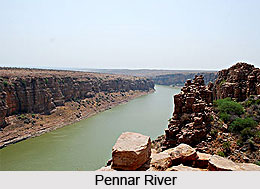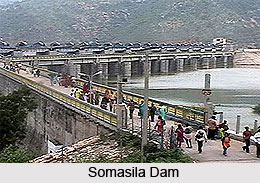 Nellore district is one of the 9 coastal districts of Andhra Pradesh and it is the Southern most one. The district lies between 13-30` and 15-6` of the Northern latitude and 70-5` and 80-15` of the Eastern Longitude and extending over an area of 13076 Sq.Kms, accounting for 4.75% of the total area of the state. It is bounded on the north by Prakasm District, on the East by Bay of Bengal on the South by Chittoor District and Chengalpattu District of Tamil Nadu, and on the West by Veligonda Hills which separate it from Kadapa District. The district is famous for high quality paddy and so got its name from "Nelli", an equivalent word for paddy in Tamil.
Nellore district is one of the 9 coastal districts of Andhra Pradesh and it is the Southern most one. The district lies between 13-30` and 15-6` of the Northern latitude and 70-5` and 80-15` of the Eastern Longitude and extending over an area of 13076 Sq.Kms, accounting for 4.75% of the total area of the state. It is bounded on the north by Prakasm District, on the East by Bay of Bengal on the South by Chittoor District and Chengalpattu District of Tamil Nadu, and on the West by Veligonda Hills which separate it from Kadapa District. The district is famous for high quality paddy and so got its name from "Nelli", an equivalent word for paddy in Tamil.
The district is broadly classified into 2 natural divisions from North to South. The eastern Half of the District adjoins the coastal belt and is fairly fertile and the western half of the district has low elevation towards the west with large track of low shrub jungles diversified with rocky will stony plains.
The principal rivers flowing through the Nellore district are the Pennar River Gundlakamma River and the Swarnamakhi River. They are not navigable and are mainly used for irrigation purposes. Besides this there are a number of smaller streams like the Kandaleru and Boggeru.
The climate of Nellore town is generally dry and salubrious. April and May are the hottest months and the hot winds generally last till the end of the June. As the Bay of Bengal is at a distance of 15 miles from the city, the sea breeze renders the climate of the city moderate both in winter and in summer. The hottest day falls in May with a shift to June during some years. The coolest day falls between the months of December and February. The southwest Monsoon is not very important for this town. Winds are from west and North - West during this season. This town and region depends mainly on the North - East monsoon. The North - East monsoon occurs along the East Coast of India during the month of October and continues till December. This period gives about 60% annual rainfall.
About one half of the total area is cultivated and the rest is waste land because it is rocky land, sandy coast line or covered with scrub jungles. The total Geographical area of the District is 13.16 lakh Hectares. Of this 41.3% alone is erable and 18.7% is forest area. The rest is distributed among Barren and Uncultivable Land (13.8%) and Land put into Non Agricultural uses (16.5%) out of the erable area. The net area sown forms 23.8% while cultivable waste and fallow (current and old) lands Constitute 11%.
 Nellore is famous for its high quality rice production and the district is particularly renowned for a particular variety of paddy, "Molagolukulu". The main crops grown are paddy and sugarcane. Aqua culture is also taken up in the district. A breed of sheep named "Jodipi" is reared by the farmers and is famous for its high quality meat. Somasila Dam and Gandipalem Reservoir supply irrigation water to many villages in the district. Also Telugu Ganga Project supports agriculture in the dry lands of the district.
Nellore is famous for its high quality rice production and the district is particularly renowned for a particular variety of paddy, "Molagolukulu". The main crops grown are paddy and sugarcane. Aqua culture is also taken up in the district. A breed of sheep named "Jodipi" is reared by the farmers and is famous for its high quality meat. Somasila Dam and Gandipalem Reservoir supply irrigation water to many villages in the district. Also Telugu Ganga Project supports agriculture in the dry lands of the district.
The area is endowed with a number of major and minor minerals, such as mica, silica etc. It is rich in particular kind of flint called quartzite.
Administratively the District is divided into 46 Mandals, covering three Revenue Divisions with Head Quarters at Nellore, Gudur and Kavali. 46 Revenue Mandals with an equal number of Mandal Parishads are found existing in the district. There are three Municipalities namely Nellore, Gudur and Kavali and in addition there are two Census Towns i.e. Kovurpalli, Venkatagiri. The district has 11 State Assembly constituencies.
Nellore district has off late emerged as an industrial hub. Formerly the handloom sector industry and a couple of industries were located in the district. Venkatagiri and Patur are important handloom centres noted for their traditional hand crafted fine cotton and silk sarees, embroidered with pure zari.
The Sriharikota high altitude range (SHAR) of the Indian Space Research Organisation has emerged as a leading space port in the world and has successfully entered the space launch business to its credit.






